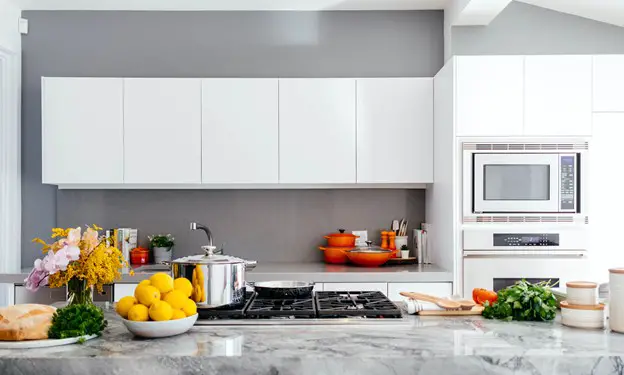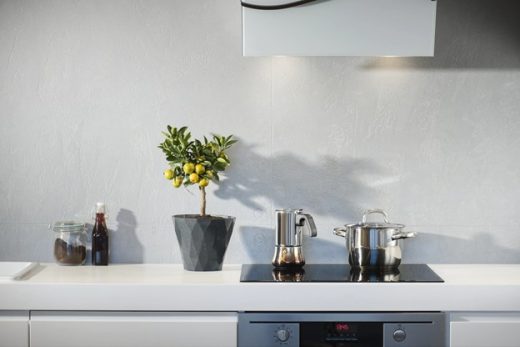8 easy ways to make your kitchen green and eco-friendly, Home interior design tips, Property style advice
How to Make Your Kitchen Green and Eco-Friendly
15 Mar 2021
One thing that keeps most people from taking the leap and going green is the effort it takes to lead an eco-friendly lifestyle, but what if we told you that this “effort” is not as burdensome as it seems? Our kitchens are where we use most of our resources, and we’re going to show you that it only takes eight easy steps to make them eco-friendly. So, prepare to get your mind blown!

How to Make Your Kitchen Green and Eco-Friendly Advice
1. Conserve Water
When it comes to conserving water, there’s no doubt you know the one basic tip, turning off the faucet when you’re not using it. While it’s an effective tip, it’s not enough to cover all the covert ways in which we waste our water. So, what to do? If you want a greener kitchen, you might want to hold off on cleaning your dishes until your dishwasher is all filled up. Half-loads and full-loads use the same amount of water, detergent, and electricity, so why not make the most out of it? In addition, if you’re using water for defrosting, use a microwave instead. It’s faster, and you won’t be wasting precious gallons.
2. Reuse Old Containers
While you shouldn’t be reusing plastic drinking bottles, there are other containers that can safely be reused without affecting your health. Let’s say, you’ve got an old ketchup bottle. The next time you’re in the store, why not get the largest ketchup container and refill your old bottle. While not perfect, this way will at least put a dent in your plastic usage. This shouldn’t apply to ketchup, either. You can also refill liquid hand soap, detergent bottles, and last but not least, spice containers.
3. Lose the Paper
We’re all guilty of using too many paper towels. Sometimes the use is warranted, but other times, it’s in excess. Luckily, we’ve found two green alternatives that can make your current paper towel roll the last one you ever use.
First and foremost, biodegradable flannel towels. They’re washable, so you won’t need to dispose of them after a single-use, and they last for quite some time. The second is quite an interesting alternative for those who don’t believe they can quit paper towels. It’s tree-free paper towels made from bamboo. Because of bamboo’s excessively fast growth rate, its use is much less detrimental to the environment than trees.
4. Lose the Plastic
Plastic makes its way into our lives in the sneakiest of manners, even in your daily cup of coffee or tea. Not only is it right there in your kettle, but it also comes in contact with your food and water. If that’s the case, perhaps it’s time to make the switch to plastic free kettles because, after all, you and our planet deserve better. While they contain some bits of plastic on the outside, the inside of these appliances is made of metal or glass. As an added bonus, you get to boil your water without worrying about your own or your children’s health.
5. Opt for Energy-efficient Appliances
When it comes to electrical equipment, efficiency is the device’s ability to use most of the power it draws. Meaning, if you have a fridge that’s 70% efficient, you’re wasting 30% of your electricity. An efficiency of 90%, however, means that you’re only wasting 10%.
Before you get your hopes up, waste is inevitable, but what we can do is buy highly efficient devices to keep this waste to a minimum. Your best bet is to look for the star sticker found on many appliances. It’s part of an EPA program that promotes efficiency. If you want to take it to the next level, their website contains loads of information about the most efficient appliances.
6. Glass Everywhere
The best thing about plastic containers is that they can easily be replaced by glass ones, and guess what, the result is always better. Who uses plastic for its sleek appearance, right? While we grew into the habit of using plastic food containers, it’s time for a change, and glass and aluminum are there to help. For one, they offer a safe alternative. Two, you can reheat glass however much you like without worrying. Three, unlike plastic, glass containers are incapable of holding onto food smells.
7. Compost
Whether it’s food scraps or fruit and vegetable peelings, we throw a lot of food away. Usually, it ends up taking space in landfill sites until it decomposes, and to think of the energy wasted to get that food waste there. The easy solution here is composting, since it eliminates waste, preserves resources, and benefits your soil. If you have a garden or if you plant your own herbs, think of the added benefits!
8. Buy Local
This one is a no-brainer. Big companies don’t care for their environmental impact. In fact, most of our problems nowadays exist because of profit margins. On the other hand, local farmers are a lot more environmentally conscious, and they use fewer resources. So, other than the economic benefits of supporting local businesses, you’d be opting for products that were through means that show respect for nature rather than means of exploitation.
As you see, going green isn’t that hard. It only takes a few lifestyle changes and a little getting used to. It is, however, essential for the well-being of our planet, and for our well-being, too! If you go through this list carefully, you will find that all these alternatives will benefit you more than what you’re using right now. So, what are you waiting for! Don’t you think it’s about time for your kitchen to go green?
Comments on this Easy Ways To Make Your Kitchen Green And Eco-Friendly article are welcome.
Kitchens
Kitchen Design Style Posts
7 Kitchen Sink Trends For Your Remodel
Kitchen renovation guidelines by Marich Inc Professionals
9 expert tips to nail your UK kitchen extension
Home Articles
Residential Architecture
Comments / photos for the 8 Easy Ways To Make Your Kitchen Green And Eco-Friendly page welcome





